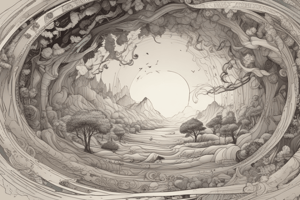Podcast
Questions and Answers
Which movement is characterized by clear images and economy of expression in poetry?
Which movement is characterized by clear images and economy of expression in poetry?
- Imagism (correct)
- Romanticism
- Surrealism
- Expressionism
Which poet's works, Cantos and Hugh Selwyn Mauberley, are recommended for exploring free verse poetry?
Which poet's works, Cantos and Hugh Selwyn Mauberley, are recommended for exploring free verse poetry?
- Ezra Pound (correct)
- E.E. Cummings
- Walt Whitman
- Robert Frost
Which poet's collection, Leaves of Grass, is highlighted as an essential work in free verse poetry?
Which poet's collection, Leaves of Grass, is highlighted as an essential work in free verse poetry?
- Walt Whitman (correct)
- Wallace Stevens
- Marianne Moore
- T.S. Eliot
In what type of verse are Ezra Pound's Cantos and Hugh Selwyn Mauberley written?
In what type of verse are Ezra Pound's Cantos and Hugh Selwyn Mauberley written?
Which poet's North of Boston and Mountain Interval collections demonstrate different facets of free verse poetry?
Which poet's North of Boston and Mountain Interval collections demonstrate different facets of free verse poetry?
What is the main difference between free verse and traditional forms of poetry?
What is the main difference between free verse and traditional forms of poetry?
What is a common convention in free verse poetry?
What is a common convention in free verse poetry?
Which aspect of free verse poetry most aligns with Carl Sandburg's description of writing without the shackles of regular meter?
Which aspect of free verse poetry most aligns with Carl Sandburg's description of writing without the shackles of regular meter?
How does free verse poetry differ from traditional poetry in terms of rhythm?
How does free verse poetry differ from traditional poetry in terms of rhythm?
What characteristic contributes to making free verse poetry both accessible and complex for readers?
What characteristic contributes to making free verse poetry both accessible and complex for readers?
Flashcards are hidden until you start studying
Study Notes
English Poetry: Embracing Free Verse
From Shakespearean sonnets to Tennyson's epic ballads, the history of English literature is filled with diverse forms of poetry. In recent centuries, however, one particular type has emerged, challenging traditional meter and rhyme schemes—free verse. This fresh approach to composition offers poets unrestricted freedom within their lines, allowing them to express ideas and emotions in ways unique to each individual voice.
Free verse does not follow strict rules like iambic tetrameter or other fixed meters we see in earlier poetry styles. Instead, it embraces rhythm through varying line lengths and emphasizes meaning over metrical conformity. As poet Carl Sandburg once famously said, "Free verse simply means writing without the shackles of regular meter." Such flexibility allows poets to experiment freely with structure, sound, and form.
However, just because free verse doesn't have formal constraints, does not mean there aren't guidelines. Some conventions common to free verse include:
- Consistent stanza length
- Varying syllable counts per line
- Strong emphasis on punctuation
- A sense of musical harmony instead of rigid meter
These elements contribute to the overall coherence and flow of a poem written in free verse, making these poems accessible yet complex for readers.
One of the most celebrated figures associated with free verse is Ezra Pound. His innovative work from the early twentieth century significantly influenced modern poetry by introducing new techniques such as imagism, a movement characterized by clear images and economy of expression. Other iconic writers who adopted this experimental style included Gertrude Stein, H.D., Marianne Moore, Wallace Stevens, William Carlos Williams, and E.E. Cummings.
As you dive deeper into the world of English poetry written in free verse, several essential works come highly recommended. Consider reading Ezra Pound’s Cantos and Hugh Selwyn Mauberley; T.S. Eliot's The Waste Land; Walt Whitman's Leaves of Grass; and Robert Frost's Mountain Interval and North of Boston collections. These selections showcase different facets of free verse and demonstrate how various writers continue to shape this versatile artform.
Engaging with free verse can offer a rewarding experience, stretching our understanding of what poetry can achieve. So whether your interest lies in crafting your own free verse compositions or delving into the depths of those created by others, exploring this dynamic genre promises to broaden your horizons while feeding your creative spirit.
Studying That Suits You
Use AI to generate personalized quizzes and flashcards to suit your learning preferences.




